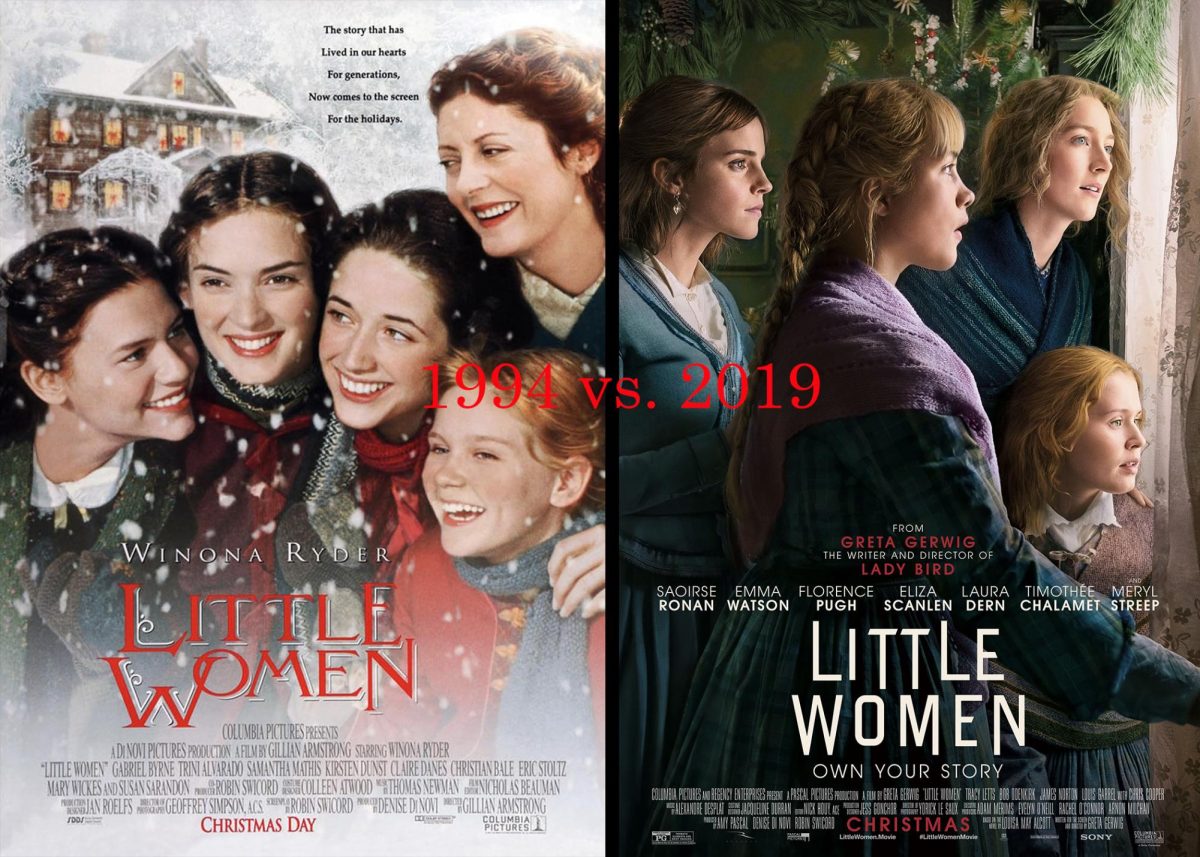When venturing elsewhere this holiday season – maybe it be to small villages or large cities, white lights, Christmas trees – take into account somewhere else. Somewhere else, somewhere idyllic, somewhere whimsical, somewhere real. The March House. In it, four sisters. Next door, a kind boy. Pianos, costumes, old candles, large trunks, and delicious food lie around as well.
Meg, Jo, Beth, and Amy sit around the fire talking about presents, each sister proposing their own response to strong-willed Jo’s grumblings that “Christmas won’t be Christmas without any presents.” Though the story of independence and growing up and sisterhood and love and loyalty begins in the wintertime, it takes a 365-day journey so we can see the March sisters in each element. In the rain, on the beach, on a green grassy hill, and, most important, for now, the snow.
While the novel “Little Women” takes place in each season, it is truly defined by the winter. The Christmas tidings and feasts and traditions of gift giving are one of importance for the story. And, of course, Jo’s grumblings are the first line.
While this story has been adapted for film many times from many different directors, two completely stand out from the rest: the 1994 version directed by Gillian Armstrong, starring Winona Ryder and Christian Bale, and the 2019 version directed by Greta Gerwig starring, Saoirse Ronan and Timothee Chalamet.
Though the story has a fair share of similarities, of course (including many Oscar nominations, and, in the case of Gerwig’s adaptation, awards), there are several differences to highlight. While overall the tone of Armstrong’s ’94 adaptation sticks to comfort, Christmas, and growing up, Gerwig’s 2019 version sticks high to themes of womanhood, independence, sisterhood, and societal ambitions and expectations. What both have in common? A star-studded cast – from Florence Pugh to Emma Watson to Claire Danes to a young Kirsten Dunst.
1994
Abundant nostalgia and a grainy production value induces the coziness of Gillian Armstrong’s 1994 adaptation of “Little Women.” There is a greater emphasis on Christmas, inviting fans of the film to return every holiday season. Louisa May Alcott’s bright, intelligent storytelling and hard-hitting themes are not lost within what might appear a children’s movie, as Armstrong explored adolescence, innocence, and decisions through the trajectory of Jo, Meg, Beth, and Amy’s lives.
The period film bypasses traditional elements of a hallmark-comfort hybrid and instead can be appreciated by all audiences as it navigates the naiveté of childhood through engaging characters and holds the rare quality of following the March family over an entire life span. The little women are each generously portrayed and gradually characterized through their interactions with each other, Marmee, and their neighbor Laurie Lawrence. Winona Ryder, a 90s icon, played Jo, bringing spunky energy to the film and exhibiting well Jo’s ambition. 1994 included various quotes verbatim from Alcott’s writing, including a scene in which Jo states, “I find it poor logic to say that because women are good, women should vote. Men do not vote because they are good; they vote because they are male, and women should vote, not because we are angels and men are animals, but because we are human beings and citizens of this country” a commonplace idea now, but divisive in the 1860s. Several instances such as the implementation of this quote make the 1994 version a faithful adaptation of the novel.
Unfortunately, Jo’s sisters did not get represented as well as the leadership-oriented middle child. Beth is labeled as “shy,” resulting in a forgettable narrative, Meg’s personal ambitions are discounted, and Amy’s story is interrupted with an abrupt actress change in the middle of the film, from Kirsten Dunst to Samantha Mathis.
Despite this film coming approximately 130 years after the book, it was still radical to produce media with a nearly entire female cast with the leadership of a female director. However, it was important to Armstrong to represent the little women’s virtues accurately and tell stories of their ambition outside the constricts of societal expectations.
2019
As Jo March stoically stands in front of her publisher’s door, we see where Jo longs to be – to be published, to be making money, and to just be writing, doing the thing she loves. As the scene transitions to her conversation with the publisher (“Make sure she’s married by the end…”), transitions out, and Jo starts to run, we see where each sister is now. Amy in a carriage with Aunt March, Meg in her home. And then suddenly we are back into childhood, back into growing up, with the four sisters in the living room and a Christmas tree in the background. Amy at center stage, Jo lounging, Beth brushing her doll’s hair, and Meg sewing. While Christmas won’t be Christmas without any presents, the sisters have each other, they have Marmee, and soon they will have Theodore Laurence as well (“Can I call you Teddy?”). But first – a dance on the porch.
Unlike the ’94 version, which is told in a linear storyline, Gerwig transitions from teenage years to young adulthood continually throughout the story. We see Amy in France, Meg married with children, and Jo in New York. Instead of guessing where the girls end up, we see how they got there – and what it took. With a light-yellow hue for childhood, and a blue hue for adulthood, we can easily see what stage the girls are at (the different hairstyles help as well).
One of the main differences between the two adaptations is the casting. We see the same people play the girls throughout, instead of casting younger and older versions of the characters. Overall, it works, though even giving Florence Pugh bangs does not necessarily make her look as young as twelve.
One of the main things Gerwig focuses on is Amy’s trajectory. As the youngest, and the one who ends up with Laurie, she is often hated throughout the story. Gerwig gave Amy redemption. Instead of annoying, we see a young, more innocent Amy (except the book burning was still terrible) grow into an ambitious, strong, smart young woman who longs to be a painter – the greatest in the world. As we see Amy tackle love, loss, and Laurie, we grow to appreciate the youngest March sister for who she is – a woman of the 1800s trying her best to make her way in the world, guided by her three older sisters. To complete the storyline, we have a more than incredible performance by Oscar nominated Florence Pugh, whose “I’m not a poet, I’m just a woman” monologue palpitates the heart.
Gerwig does not just give this to Amy, however; she gives each character full redemption. Instead of seeing Beth as the third sister who dies from scarlet fever, we see a young girl bursting with love and loyalty to her family, constant compassion for others, and someone with intense musical talent. Beth’s storyline continues when she befriends Laurie’s grandfather and starts playing his piano, which his late daughter had played. We see Beth selflessly take care of the Hummel family when they were ridden with scarlet fever. And we see her constantly cheer on her sisters through every piece of narrative excitement.
One of the biggest pieces of the story is the struggle of love between Laurie and Jo. (“Jo, we’ve got to have it out.”) Jo’s loneliness is a big part of her character trajectory. Gerwig took a letter Lousia May Aclott wrote and turned it into a monologue, beautifully performed by Saoirse Ronan, that highlights Jo’s desire for women to be more than heart, beauty, and love, and instead exclaiming how women have minds, souls, ambition, and talent. But, Jo confesses, she’s so lonely. While Laurie is not Jo’s romantic love, he is her best friend, and they each find their person in the end…hers under an umbrella in the rain, his coming home from Paris.
Marmee, the beloved mother of the four girls, is more than Mother in Gerwig’s adaptation. “I’m angry almost every day of my life,” she explains to Jo after Jo regrets the rage she expressed earlier. “But you’re never angry,” Jo had insisted, her mother perfect in her eyes. Marmee, missing her husband off helping in the war, is an important role. Played by the impressive Laura Dern, Marmee guides her girls through life as she heavily grieves the loss of Beth.
Everyone has a storyline in Gerwig’s adaptation, and the importance of Meg’s does not go unseen. Meg wants to marry, and she wants to be a mother. While her sisters focus on different ambitions – Jo suggesting she might never marry, Amy dreaming on being the best painter and later deciding to marry rich – Meg knows what she wants, and when she meets John Brooke, it happens. (“Ms. Meg, your glove!”) While Jo fights to be seen as a writer, we see Meg follow her dream as well; more than thrilled to marry John and later have twins nicknamed Daisy and Demi. Though some thought Meg’s dream went against the feminist themes in the movie, it is the contrary. Meg is a selfless young woman who has ambitions of her own – she falls in love, she enjoys the fancy things, and she is a loving mother. She works hard for herself and others, just like her sisters. And she appreciates her sisters as she goes through every step, standing with them every part of her journey as well. Meg explains it best to a homesick-for-childhood Jo: “Just because my dreams are different than yours, doesn’t mean they’re unimportant.”
“‘Christmas won’t be Christmas without any presents,’ grumbled Jo, lying on the rug” is the catalyst for Alcott’s magnum opus, but since the novel hit the shelves, Christmas has not been Christmas without Little Women. To incorporate more of the magic into your holiday, we recommend replicating some of the culinary creations, aided by Taste of Home. Or, if you are less inclined to chef up peppermint ice cream as part of your Christmas breakfast and more likely to stop at Trader Joe’s, you can partake in ice skating, (just do not fall unless Laurie and Jo are present), learn a Beth-inspired song on the piano, or put on a spirited play.














